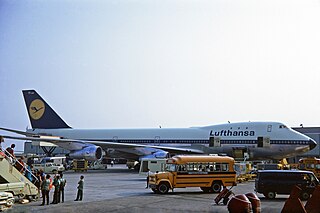In aviation, a go-around is an aborted landing of an aircraft that is on final approach or has already touched down. A go-around can either be initiated by the pilot flying or requested by air traffic control for various reasons, such as an unstabilized approach or an obstruction on the runway.

American Airlines Flight 1420 was a flight from Dallas/Fort Worth International Airport (DFW) to Little Rock National Airport in the United States. On June 1, 1999, the McDonnell Douglas MD-82 operating as Flight 1420 overran the runway upon landing in Little Rock and crashed. Nine of the 145 people aboard were immediately killed—the captain and eight passengers.

United Airlines Flight 232 was a regularly scheduled United Airlines flight from Stapleton International Airport in Denver to O'Hare International Airport in Chicago, continuing to Philadelphia International Airport. On July 19, 1989, the DC-10 serving the flight crash-landed at Sioux Gateway Airport in Sioux City, Iowa, after suffering a catastrophic failure of its tail-mounted engine due to an unnoticed manufacturing defect in the engine's fan disk, which resulted in the loss of many flight controls. Of the 296 passengers and crew on board, 112 died during the accident, while 184 people survived. 13 of the passengers were uninjured. It was the deadliest single-aircraft accident in the history of United Airlines.

Aviation safety is the study and practice of managing risks in aviation. This includes preventing aviation accidents and incidents through research, educating air travel personnel, passengers and the general public, as well as the design of aircraft and aviation infrastructure. The aviation industry is subject to significant regulation and oversight.

Lufthansa Flight 540 was a scheduled commercial flight for Lufthansa, serving the Frankfurt–Nairobi–Johannesburg route.

Republic Airport is a regional airport in East Farmingdale, New York, located one mile east of Farmingdale village limits.

Pilot error generally refers to an accident in which an action or decision made by the pilot was the cause or a contributing factor that led to the accident, but also includes the pilot's failure to make a correct decision or take proper action. Errors are intentional actions that fail to achieve their intended outcomes. The Chicago Convention defines the term "accident" as "an occurrence associated with the operation of an aircraft [...] in which [...] a person is fatally or seriously injured [...] except when the injuries are [...] inflicted by other persons." Hence the definition of "pilot error" does not include deliberate crashing.

Oakland County International Airport is a county-owned public-use airport located in Waterford Township, Oakland County, Michigan, United States. The airport is located approximately one mile from the center of Waterford Township and Oakland County. It is included in the Federal Aviation Administration (FAA) National Plan of Integrated Airport Systems for 2017–2021, in which it is categorized as a non primary commercial service facility.

Armavia Flight 967 was a scheduled international passenger flight operated by Armavia from Zvartnots International Airport, Zvarnots in Armenia to Sochi, a Black Sea coastal resort city in Russia. On 3 May 2006, the aircraft operating the route, an Airbus A320-200, crashed into the sea while attempting a go-around following its first approach to Sochi airport; all 113 aboard were killed. The accident was the first major commercial airline crash in 2006. It was Armavia's only fatal crash during the airline's existence.

Jackson County Airport, also known as Reynolds Field, is a county-owned, public-use airport located two nautical miles (3.7 km) west of the central business district of Jackson, in Jackson County, Michigan, United States. It is a class D airport with operating control tower. It is included in the Federal Aviation Administration (FAA) National Plan of Integrated Airport Systems for 2017–2021, in which it is categorized as a regional general aviation facility.
Portage County Airport, also known as Portage County Regional Airport, is a public use airport in Portage County, Ohio, United States. It is owned by the Portage County Board of Commissioners and located three nautical miles (6 km) north of Ravenna, in Shalersville Township. This airport is included in the National Plan of Integrated Airport Systems for 2011–2015, which categorized it as a general aviation facility.

Malév Hungarian Airlines Flight 262 was a flight from Budapest Ferihegy International Airport to Thessaloniki International Airport. On 4 July 2000, a Tupolev Tu-154, belonging to Malév Hungarian Airlines, used on this flight performed a gear-up touchdown during the landing at Thessaloniki, skidded on the runway, but was able to take off and land normally after a go-around. No injuries were reported.

Turkish Airlines Flight 634 was a scheduled domestic passenger flight from Turkish Airlines' hub at Istanbul Atatürk Airport to Diyarbakır Airport in southeastern Turkey. On 8 January 2003 at 20:19 EET, the aircraft operating the flight, a British Aerospace Avro RJ100, struck the ground on final approach approximately 900 metres (3,000 ft) short of the runway threshold during inclement weather conditions. In the following collision with a slope, a post-crash fire broke out, killing 75 of the 80 occupants, including the entire crew. This is the deadliest aviation accident to involve the BAe 146.

Carroll County–Tolson Airport is a county–owned, public-use airport located one nautical mile (1.85 km) southeast of the central business district of Carrollton, a village in Carroll County, Ohio, United States. It is owned by the Carroll County Airport Authority. According to the FAA's National Plan of Integrated Airport Systems for 2009–2013, it is categorized as a general aviation airport.
Flight Express, Inc. was a cargo airline owned by Bayside Capital. Bayside Capital acquired Flight Express on November 4, 2008. Flight Express, Inc. operates as an air courier company in the Southeast and Midwest United States. It offers air freight and ground courier services. The company also operates aircraft. It specializes in the transport of cargo for banking and financial institutions, life sciences organizations, newspaper publishers, overnight freight delivery companies, and payroll and photographic processors. It operates 84 aircraft from facilities in eight states. It was founded in 1985 and is based in Orlando, Florida, USA.
Dalton Airport is a privately owned, public use airport located two nautical miles (4 km) east of the central business district of Flushing, in Genesee County, Michigan, United States. It is named after its founder, Edwin P. Dalton, who opened it in 1946 on the former site of the Marsa farm.

On October 30, 2014, a Beechcraft King Air B200 twin turboprop crashed into a building hosting a FlightSafety International (FSI) training center shortly after taking off from Wichita Mid-Continent Airport in Wichita, Kansas. The pilot, the only person on board, was killed along with three people in the building; six more people in the building were injured.

On 28 July 2018, Air Vanuatu Flight 241, operated by ATR-72 registration YJ-AV71 suffered an in-flight engine fire while operating a domestic scheduled passenger flight from Whitegrass Airport, Tanna to Bauerfield International Airport, Port Vila, Vanuatu. On landing at Port Vila, a runway excursion occurred. The aircraft collided with two Britten-Norman Islanders, writing one off and severely damaging the other. 13 of the 43 people on board sustained minor injuries.


















